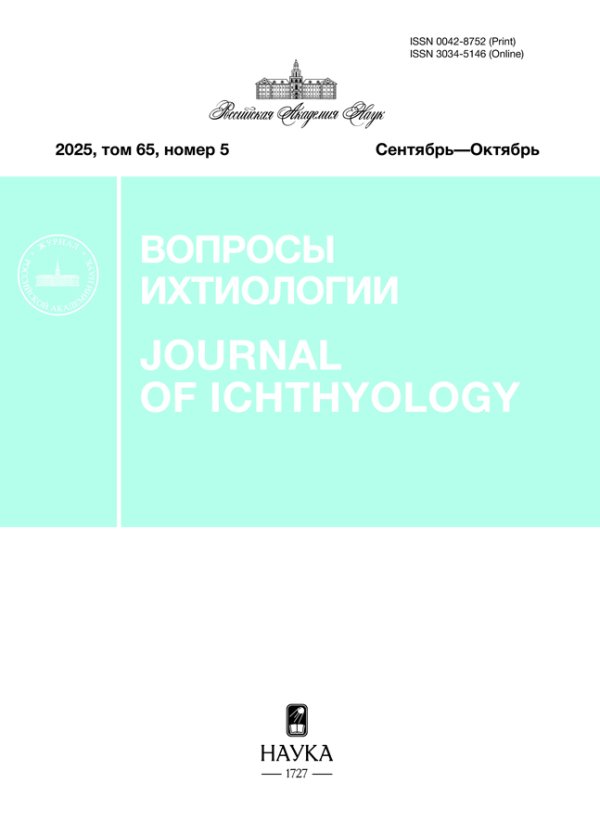Effects of Salinity on Lipid Composition in Juvenile Pinc Salmon Oncorhynchus gorbuscha (Salmonidae)
- Authors: Vasileva O.B.1, Efremov D.A.1, Ruokolainen T.R.1, Nemova N.N.1
-
Affiliations:
- Institute of Biology, Karelian Research Center, Russian Academy of Sciences, Petrozavodsk, Russia
- Issue: Vol 63, No 3 (2023)
- Pages: 365-371
- Section: Articles
- URL: https://journals.rcsi.science/0042-8752/article/view/135198
- DOI: https://doi.org/10.31857/S0042875223030232
- EDN: https://elibrary.ru/BZDIYA
- ID: 135198
Cite item
Full Text
Abstract
Lipid and fatty acid modifications induced by the effects of various salinity patterns on the juvenile pink salmon Oncorhynchus gorbuscha (the Olkhovka River and the White Sea) within the experiment have been revealed. Concentrations of steroids, saturated fatty acids, and signaling molecules such as phospholipids (phosphatidylserine and phosphatidylinositol) and arachidonic acid under the hyperosmotic stress-related effects (keeping the fish for 1 h in the seawater after the time of transfer from the freswater) tend to increase. Decreases in phosphatidylcholine and n-6 saturated, monounsaturated, and polyunsaturated fatty acids are recorded in the juvenile pink salmon fish kept for 24 h in the seawater after the time of transfer them from the freswater, while the levels of phosphatidylethanolamine and n-3 polyunsaturated fatty acids (especially eicosapentaenoic and docosahexaenoic acids), on the contrary, tend to rise significantly. Lipid composition modifications in the juvenile pink salmon fish kept under the hypoosmotic stress conditions (24 h in freshwater after 24 h in seawater) induce stabilization of functioning the cell membrane structure, since the levels of bioeffectors including phosphatidylserine, phosphatidylinositol, and arachidonic, eicosapentaenoic, and docosahexaenoic acids tend to decrease. A reduced amount of lipids (triacylglycerols) stored as an energy reserve is shown for all the experimental fish groups. The outcomes indicate the high levels of adaptive potential of the juvenile pink salmon fish kept under the effects of abrupt salinity change in the water environments and their readiness for downstream migration not long before leaving the nests.
About the authors
O. B. Vasileva
Institute of Biology, Karelian Research Center, Russian Academy of Sciences, Petrozavodsk, Russia
Email: vasil@krc.karelia.ru
Россия, Петрозаводск,
D. A. Efremov
Institute of Biology, Karelian Research Center, Russian Academy of Sciences, Petrozavodsk, Russia
Email: vasil@krc.karelia.ru
Россия, Петрозаводск,
T. R. Ruokolainen
Institute of Biology, Karelian Research Center, Russian Academy of Sciences, Petrozavodsk, Russia
Email: vasil@krc.karelia.ru
Россия, Петрозаводск,
N. N. Nemova
Institute of Biology, Karelian Research Center, Russian Academy of Sciences, Petrozavodsk, Russia
Author for correspondence.
Email: vasil@krc.karelia.ru
Россия, Петрозаводск,
References
- Богданов М., Доухан В. 1999. Липид-опосредованный фолдинг белка // Журн. биол. химии. Т. 274. С. 827–830.
- Елисеева И.И. 2007. Статистика. М.: Высш. образование, 566 с.
- Крепс Е.М. 1981. Липиды клеточных мембран. Л.: Наука, 339 с.
- Немова Н.Н., Кяйвяряйнен Е.И., Рендаков Н.Л. и др. 2021. Содержание кортизола и активность Na+/K+-АТФазы при адаптации молоди горбуши Oncorhynchus gorbuscha (Salmonidae) к изменению солёности среды // Вопр. ихтиологии. Т. 61. № 5. С. 599–606. https://doi.org/10.31857/S0042875221050131
- Сидоров В.С., Лизенко Е.И., Болгова О.М., Нефедова З.А. 1972. Липиды рыб. 1. Методы анализа. Тканевая специфичность ряпушки Coregonus albula L. // Лососёвые (Salmonidae) Карелии. Петрозаводск: Изд-во Карел. фил. АН СССР. С. 152–163.
- Цыганов Э.П. 1971. Метод прямого метилирования липидов после ТСХ без элюирования с силикагеля // Лаб. дело. № 8. С. 490–493.
- Шталь Э. 1965. Хроматография в тонких слоях. М.: Мир, 508 с.
- Allen P.J., McEnroe M., Forostyan T. et al. 2011. Ontogeny of salinity tolerance and evidence for seawater-entry preparation in juvenile green sturgeon, Acipenser medirostris // J. Comp. Physiol. B. V. 181. № 8. P. 1045–1062. https://doi.org/10.1007/s00360-011-0592-0
- Arjona F.J., Vargas-Chacoff L., Ruiz-Jarabo I. 2007. Osmoregulatory response of Senegalese sole (Solea senegalensis, Kaup 1858) to changes in environmental salinity // Comp. Biochem. Physiol. A. V. 148. № 2. P. 413–421. https://doi.org/10.1016/j.cbpa.2007.05.026
- Babili M.E., Brichon G., Zwingelstein G. 1996. Sphingomyelin metabolism is linked to salt transport in the gills of euryhaline fish // Lipids. V. 31. № 4. P. 385–392. https://doi.org/10.1007/BF02522924
- Bell J.G., Tocher D.R., Farndale B.M. et al. 1997. The effect of dietary lipid on polyunsaturated fatty acid metabolism in Atlantic salmon (Salmo salar) undergoing parr-smolt transformation // Ibid. V. 32. № 5. P. 515–525. https://doi.org/10.1007/s11745-997-0066-4
- Daikoku T., Yano I., Masuf M. 1982. Lipid and fatty acid composition and their changes in the different organs and tissues of guppy Poecilia reticulata on sea water adaptation // Comp. Biochem. Physiol. A. V. 73. № 2. P. 167–174. https://doi.org/10.1016/0300-9629(82)90050-0
- Engelbrecht F.M., Mari F., Anderson J.T. 1974. Cholesterol determination in serum. A rapid direction method // S. Afr. Med. J. V. 48. № 2. P. 250–256.
- Folch J., Lees M., Stanley G.H.S. 1957. A simple method for the isolation and purification of total lipides from animal tissues // J. Biol. Chem. V. 226. № 1. P. 497–509. https://doi.org/10.1016/S0021-9258(18)64849-5
- Folmar L.C., Dickhoff W.W. 1980. The parr-smolt transformation (smoltification) and seawater adaptation in salmonids // Aquaculture. V. 21. № 1. P. 1–37. https://doi.org/10.1016/0044-8486(80)90123-4
- Guidelines for the use of fishes in research. 2014. Bethesda: Am. Fish. Soc., 90 p.
- Handeland S.O., Bjornsson B.T., Arnesen A.M., Stefansson S.O. 2003. Seawater adaptation and growth of post-smolt Atlantic salmon (Salmo salar) of wild and fanned strains // Aquaculture. V. 220. № 1–4. P. 367–384. https://doi.org/10.1016/S0044-8486(02)00508-2
- Hansen H.J.M., Kelly S.P., Grosell M., Wood C.M. 2002. Studies on lipid metabolism in trout (Oncorhynchus mykiss) branchial cultures // J. Exp. Zool. V. 293. № 7. P. 683–692. https://doi.org/10.1002/jez.10166
- Harel M., Gavasso S., Leshin J. et al. 2001. The effect of tissue docosahexaenoic and arachidonic acids levels on hypersaline tolerance and leucocyte composition in striped bass (Morone saxatilis) larvae // Fish Physiol. Biochem. V. 24. № 2. P. 113–123. https://doi.org/10.1023/A:1011924704459
- Herrera M., Vargas-Chacoff L., Hachero I. et al. 2009. Osmoregulatory changes in wedge sole (Dicologoglossa cuneata, Moreau, 1881) after acclimation to different environmental salinities // Aquac. Res. V. 40. № 7. P. 762–771. https://doi.org/10.1111/j.1365-2109.2008.02147.x
- Hochachka P.W., Somero G.N. 2002. Biochemical adaptation: mechanism and process in physiological evolution. N.Y.: Oxford Univ. Press, 466 p.
- Hunt A.O., Oxkan F.E., Engin K., Tekelioglu N. 2011. The effects of freshwater rearing on the whole body and muscle tissue fatty acid profile of the European sea bass (Dicentrarchus labrax) // Aquacult. Int. V. 19. № 1. P. 51–61. https://doi.org/10.1007/s10499-010-9340-9
- Jamieson G.R. 1975. GLS identification techniques for long-chain unsaturated fatty acids // J. Chromatogr. Sci. V. 13. № 10. P. 491–497. https://doi.org/10.1093/chromsci/13.10.491
- Jana L., Huang X., Zhang L., Zhuang P. 2006. Hematological parameters of Amur sturgeon, Acipenser schrencki, during different salinity domestication // Mar. Fish. V. 28. P. 177–184.
- Kültz D. 2015. Physiological mechanisms used by fish to cope with salinity stress // J. Exp. Biol. V. 218. № 12. P. 1907–1914. https://doi.org/10.1242/jeb.118695
- Li H.-O., Yamada J. 1992. Changes of the fatty acid composition in smolts of Masu salmon (Oncorhynchus masou), associated with desmoltification and seawater transfer // Comp. Biochem. Physiol. A. V. 103. № 1. P. 221–226. https://doi.org/10.1016/0300-9629(92)90266-S
- Li S., He F., Wen H. et al. 2017. Low salinity affects cellularity, DNA methylation, and mRNA expression of igf1 in the liver of half smooth tongue sole (Cynoglossus semilaevis) // Fish Physiol. Biochem. V. 43. № 6. P. 1587–1602. https://doi.org/10.1007/s10695-017-0395-7
- Logue J.A., Howell B.R., Bell J.G., Cossins A.R. 2000. Dietary n-3 long-chain polyunsaturated fatty acid deprivation, tissue lipid composition, ex vivo prostaglandin production, and stress tolerance in juvenile Dover sole (Solea solea L.) // Lipids. V. 35. №. 7. P. 745–755. https://doi.org/10.1007/s11745-000-0581-3
- Mancera J.M., McCormick S.D. 2007. Role of prolactin, growth hormone, insuline-like growth factor and cortisol in teleost osmoregulation // Fish Osmoregulation. N.Y.: Sci. Pub. P. 497–515. https://doi.org/10.1201/9780429063909
- Marshall W.S. 2002. Na+, Cl−, Ca2+ and Zn2+ transport by fish gills: retrospective review and prospective synthesis // J. Exp. Zool. V. 292. № 3. P. 264–293. https://doi.org/10.1002/jez.10127
- Martins Y.S., Melo R.M.C., Campos-Junior P.H.A. et al. 2014. Salinity and temperature variations reflecting on cellular PCNA, IGF-I and II expressions, body growth and muscle cellularity of a freshwater fish larvae // Gen. Comp. Endocrinol. V. 202. P. 50–58. https://doi.org/10.1016/j.ygcen.2014.03.047
- McKenzie D.J., Cataldi E., Romano P. et al. 2001. Effects of acclimation to brackish water on tolerance of salinity challenge by young-of-the-year Adriatic sturgeon (Acipenser naccarii) // Can. J. Fish. Aquat. Sci. V. 58. № 6. P. 1113–1121. https://doi.org/10.1139/f01-058
- Mustafa T., Srivastava K.C. 1989. Prostaglandins (eicosanoids) and their role in ectothermic organisms // Adv. Comp. Environ. Physiol. V. 5. P. 157–207. https://doi.org/10.1007/978-3-642-74510-2_6
- Robertson J.C., Hazel J.R. 1999. Influence of temperature and membrane lipid composition on the osmotic water permeability of teleost gills // Physiol. Biochem. Zool. V. 72. № 5. P. 623–632. https://doi.org/10.1086/316699
- Sangiao-Alvarellos S., Arjona F.J., Martín del Río M.P. et al. 2005. Time course of osmoregulatory and metabolic changes during osmotic acclimation in Sparus auratus // J. Exp. Biol. V. 208. № 22. P. 4291–4304. https://doi.org/10.1242/jeb.01900
- Sarkheil M., Sorki M.P., Raefipour H. 2017. Effects of acclimation to seawater salinity on some blood parameters in wild Caspian brown trout, Salmo trutta caspius // Comp. Clin. Pathol. V. 26. № 6. P. 1315–1318. https://doi.org/10.1007/s00580-017-2531-2
- Si Y., Wen H., Li Y. et al. 2018. Liver transcriptome analysis reveals extensive transcriptional plasticity during acclimation to low salinity in Cynoglossus semilaevis // BMC Genomics. V. 19. Article 464. https://doi.org/10.1186/s12864-018-4825-4
- Soengas J.L., Sangiao-Alvarellos S., Laiz-Carrio’n R., Mancera J.M. 2007. Energy metabolism and osmotic acclimation in teleost fish // Fish osmoregulation. N.Y.: Sci. Pub. P. 277–308. https://doi.org/10.1201/9780429063909
- Tocher D.R., Sargent J.R. 1987. The effects of calcium ionophore A23187 on the metabolism of arachidonic and eicosapentaenoic acids in neutrophils from a marine teleost fish rich in (n-3) polyunsaturated fatty acids // Comp. Biochem. Physiol. B. V. 87. № 4. P. 733–739. https://doi.org/10.1016/0305-0491(87)90381-6
- Tocher D.R., Castell J.D., Dick J.R., Sargent J.R. 1995. Effects of salinity on the fatty acid compositions of total lipid and individual glycerophospholipid classes of Atlantic salmon (Salmo salar) and turbot (Scophthalmus maximus) cells in culture // Fish Physiol. Biochem. V. 14. № 2. P. 125–137. https://doi.org/10.1007/BF00002456
- Tocher D.R., Bendiksen E.A., Campbell P.J., Bell J.G. 2008. The role of phospholipids in nutrition and metabolism of teleost fish // Aquaculture. V. 280. № 1–4. P. 21–34. https://doi.org/10.1016/j.aquaculture.2008.04.034
- Vargas-Chacoff L., Saavedra E., Oyarzun R. et al. 2015. Effects on the metabolism, growth, digestive capacity and osmoregulation of juvenile of Sub-Antarctic Notothenioid fish Eleginops maclovinus acclimated at different salinities // Fish Physiol. Biochem. V. 41. № 6. P. 1369–1381. https://doi.org/10.1007/s10695-015-0092-3
- Wedermeyer G.A., Saunders R.L., Clarke W.C. 1980. Environmental factors affecting smoltification and early marine survival of anadromous salmonids // Mar. Fish. Rev. V. 42. № 6. P. 1–14.
- Zwingelstein G., Bodennec J. 1998. Phospholipid metabolism in euryhaline fish and crustaceans. Effects of environmental salinity and temperature // Recent Res. Dev. Lipids Res. V. 2. P. 39–52.
Supplementary files











